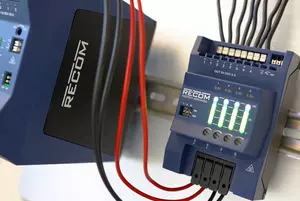문제: 긴 케이블을 따른 전압 강하
총 길이가 50m(왕복25m)인 2.5mm
2 케이블의 총 저항은 174m옴입니다. 회로 차단기의 내부 저항은 56mΩ입니다. 애플리케이션 #2의 일반적인 부하는 5A입니다.
애플리케이션 #2의 최종 공급 전압은 다음과 같습니다:
Vsupply - IR = 24V - (5A x 230m옴) = 22.85V.
이 공급 전압은 공칭 24V 공급 수준보다 낮습니다.

그림 2: 출력 전압 트림
해결책 : 전압 강하를 보정하기 위해 RACPRO1 Vout 트림을 사용하세요.
RACPRO1 시리즈에는 긴 케이블의 전압 강하를 보정하기 위해 출력 전압을 미세 조정할 수 있는 전면 패널 조정 트리머가 포함되어 있습니다(그림 2). 이 예에서는 출력을 최대 24.6V까지 조정하여 전압 강하를 균형 있게 조정할 수 있습니다.
- 애플리케이션 #1은 24.6V(공칭보다 600mV 높음)를 공급받습니다.
- 애플리케이션 #2는 23.4V(공칭보다 600mV 낮음)를 공급받습니다.
두 공급 전압 모두 허용 가능한 ±2.5% 범위 내에서 유지됩니다.
문제: 안전한 DC 접점 차단기 트립
열 자기 DC 회로 차단기는 두 가지 특성을 결합한 과부하 트립 곡선으로 작동합니다:
- 열 트립은 지속적인 과부하에 반응하여 전류가 과도하게 유지되면 부하를 차단합니다.
- 마그네트 트립은 훨씬 빠르게 반응하지만 활성화하려면 더 높은 과전류 서지가 필요합니다.
두 가지 트립 메커니즘 모두 아래 그림과 같이 내장된 허용 오차를 가지고 있습니다(그림 3):
그림 3: 일반적인 DC 회로 차단기 및 트립 특성
공칭 부하 전류 (5A) 에서는 회로 차단기는 영향을 받지 않습니다. 시동 전류가 10A에 이르는 경우에도 과전류 상황이 5초 미만 지속되는 한(열적 특성) 트립되지 않습니다. 단락 오류 발생 시, 전원 공급 장치가 최대 출력 전류(20A)를 제공하면 결국 열 트립이 활성화되지만, 반응하는 데 1.5초에서 10초가 걸립니다(점선). 이 지연 시간이 너무 길면 부하가 손상되거나 과열되는 것을 방지하기 어렵습니다.
해결책: RACPRO1을 이용한 간편한 퓨즈 트립
다행히 RACPRO1 시리즈는 최대 20ms 동안 250%의 단기 퓨즈 트립 전류를 공급할 수 있습니다. 480W 버전의 경우 이는 250% x 20A = 50A에 해당합니다. 이 수준에서 회로 차단기는 빠르게 반응하는 자기 트립 모드로 전환되어 2ms 에서 10ms(노란색 점선) 이내에 트립할 수 있습니다.
문제: 안전한 DC 퓨즈 트립
회로 차단기 대신 DC 퓨즈를 사용할 수 있습니다. 이는 보다 비용 효율적인 옵션이며 LED 표시기가 내장된 DIN 레일 장착형 퓨즈 홀더를 손쉽게 구할 수 있습니다(그림 4). 그러나 높은 돌입 전류로 인한 불필요한 트립을 방지하고 노후화 또는 높은 작동 온도로 인한 장기적인 성능 저하를 고려하려면 더 높은 등급의 퓨즈가 필요합니다. 5A 부하의 경우 7.5A 퓨즈를 사용하는 것이 권장됩니다.
그림 4: DIN 레일 마운팅의 DC 퓨즈 및 일반적인 특성(25°C 기준)
5A 부하 전류에서 7.5A 퓨즈는 정상 작동 중에 정상적으로 유지됩니다. 최대 10A의 높은 시동 전류에서도 과전류 이벤트가 5초 미만(점선) 지속되는 경우 퓨즈가 트립되지 않습니다. 단락 오류가 발생하고 전원 공급 장치가 최대 출력 전류(20A)를 제공하는 경우, 퓨즈가 끊어지지만 반응 시간은 200ms입니다(빨간색 점선) 비교적 빠르긴 하지만, 민감한 일부 애플리케이션에서는 이 지연 시간이 여전히 너무 길 수 있습니다.
해결책 : RACPRO1을 이용한 간편한 퓨즈 트립
다행히 RACPRO1 시리즈는 20ms 동안 250%의 단기 퓨즈 트립 전류를 제공합니다. 480W 버전의 경우, 이는 250% x 20A = 50A에 해당하며, 4ms 이내에 DC 퓨즈가 트립되도록 보장합니다. (노란색 점선).
결론
단락 보호 전원 공급 장치를 사용하더라도 출력에 DC 회로 차단기나 퓨즈를 설치하면 추가 보호에 도움이 되는 애플리케이션이 있습니다. 그러나 이러한 구성 요소는 긴 공급 케이블과 마찬가지로 전압 강하를 유발할수 있습니다. 이러한 전압 강하를 보정하기 위해 전면 패널의 출력 전압 트림 기능을 사용할 수 있습니다.
외부 회로 차단기 또는 퓨즈를 사용할 때는 전원 공급 장치가 즉각적인 단락 보호 모드로 전환되지 않으면서 단기 과전류를 전달하여 과전류 보호 장치가 제대로 작동하는지 확인하는 것이 중요합니다. RACPRO1 시리즈는 250%/20ms의 간편한 퓨즈 트립 전류를 제공합니다.








